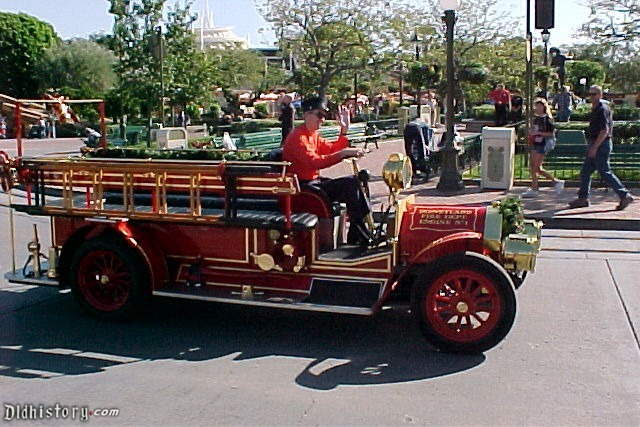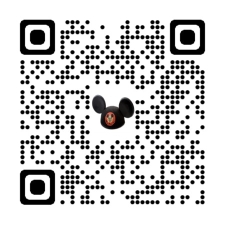
Motorized Fire Truck

Last Updated: November 4, 2024
This Disneyand version of an early model fire engine has a honking horn instead of a siren.
ID:
TMS-493
Dates Open:
Replaced By:
Land:
Photos:
Construction: 0
Onstage: 15
Backstage: 0
Articles:
Ride Layout:
Deaths & Injuries:
Deaths: 0
Injuries: 0
Audio Clips:
0
Videos:
2
Video Excerpt:
DailyMotion Video Link:
Movie Tie-In:
Google Maps:
Not Available
Wikipedia:
Not Available
Patents:
None
Specifications:
Available
Motorized Fire Truck Multimedia
Videos

Motorized Fire Truck History:
The last vintage vehicle to appear was another Bob Gurr creation the Motorized Fire Truck that began carrying small groups of guests on August 16th 1958. To deliver his creation to the park Gurr actually drove the truck down the freeway for almost an hour from Disney Studios where it was built to Anaheim. Inspired by the turn of the century fire engines. The fire truck carries links hose along sides and has a bell mounted at the rear the siren has been replaced by a horn.
From Main Street Vehicles Story Guide 1966:The motorized fire engine is similarly a composite design of a hose carrying fire engine of the turn of the century.
Specs Capacity per hour 216 -- Capacity per Vehicle 12 -- Cycle Time 6:40 -- Load Time :30 -- Unload Time :20 Trip Time 2:30 -- Dispatch Interval 3:20 -- Trips per hour 18 -- Distance Traveled 1940 feet -- Speed 4.4 MPH
Motorized Fire Truck Secrets:

At the turn of the century, gas-driven cars were considered a novelty — and a hazard — lacking the reliability of a horse. Motorized fire equipment merely supplementary to the more respected steed.
Required an "A" ticket in 1964-1965
From Main Street Vehicles Story Guide 1966:
The motorized fire engine is similarly a composite design of a hose carrying fire engine of the turn of the century. The primary change we made was to place seats where the hose was carried. The Studio men designed a chassis, then pored through standard catalogue for unlikely, but practical equipment — a jeep rear axle, a three-speed truck transmission, the power plant of a small pick-up truck and standard drive-line parts. The bell and the siren are authentic, purchased after considerable search.
From WED Disneyland Dictionary 1968
Answer "alarms" with visitors aboard. The two 1900-era fire engines begin their bell-ringing journey down Main Street from the Disneyland Fire Department in Town Square.
From 1970's Attraction Showmanship:
The motorized fire engine is a composite design of a hose-carrying fire engine of the turn of the century. The primary change made on the Disney fire engine was to place seats where the hose was carried. "Imagineers" designed a chassis, then pored through standard catalogues for practical equipment--a jeep rear axle, a three-speed truck transmission and standard drive-line parts. The bell and siren are authentic, purchased after considerable search. Lacking the reliability of the horse, motorized fire equipment was merely supplementary to the more respected steed.
Required an "A" ticket in 1970's
Motorized Fire Truck Specifications:


THEORETICAL CAPACITY
This figure is what the attraction should yield under ideal conditions utilizing all units in the system with no loss in efficiency at any position. This figure should be seldom or never attained. It is an ideal against which to measure.
Theoretical Capacity:
216 per hour

DISPATCH INTERVAL
The time interval between the dispatching of units.
Dispatch Interval:
3:20

INSTANTANOUS CAPACITY
Number of guests that can be handled when ride opens
Instantanous Capacity:
Trips:
18 per hour:
Audience Control Capacity:

DISTANCE
Distance Traveled
Distance:
1940 feet

CAPACITY PER UNIT
Capacity for each vehicle or show
Capacity Per Unit:
12

SPEED
Average speed vehicles travel
Speed:
4.40

CYCLE TIME
From the time a unit passes any given point in the cycle until it returns to that same point.
Cycle Time:
6:40

QUEUE FACTOR
Average wait time; the number of minutes from the time a guest steps into a line until he actually sets foot on an attraction. 1965
Queue Factor:
Negligible

LOAD TIME
From the time the guest(s) begins to enter the unit until the guest(s) is seated and the unit is safe to dispatch.
Load Time:
0:30

TRIP TIME
From dispatch to unload.
Trip Time:
2:30

ATTENDANCE FACTOR
(Total Guests Carried/Total Main Gate Attendance) * 100 (1964)
Attendance Factor:
4.2

UTILIZATION FACTOR
Capacity Percentage * Attendance Percentage (1964)
Utilization Factor:
2.2






MickeyMousePark.com TikTok Channel:

MickeyMousePark.com BlueSky Channel:

Copyright: (c) 1997-2025 by
ThrillMountain Software
MickeyMousePark.com is not associated in any official way with the Walt Disney Company,
its subsidiaries, or its affiliates.
The official Disney site is available at
disney.com





